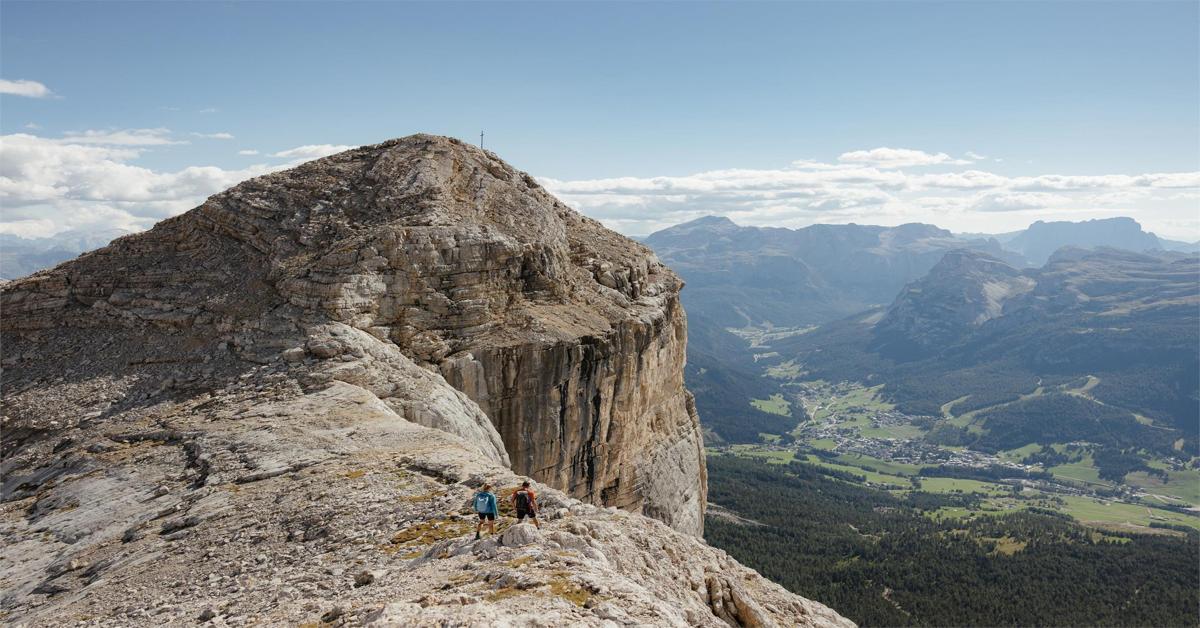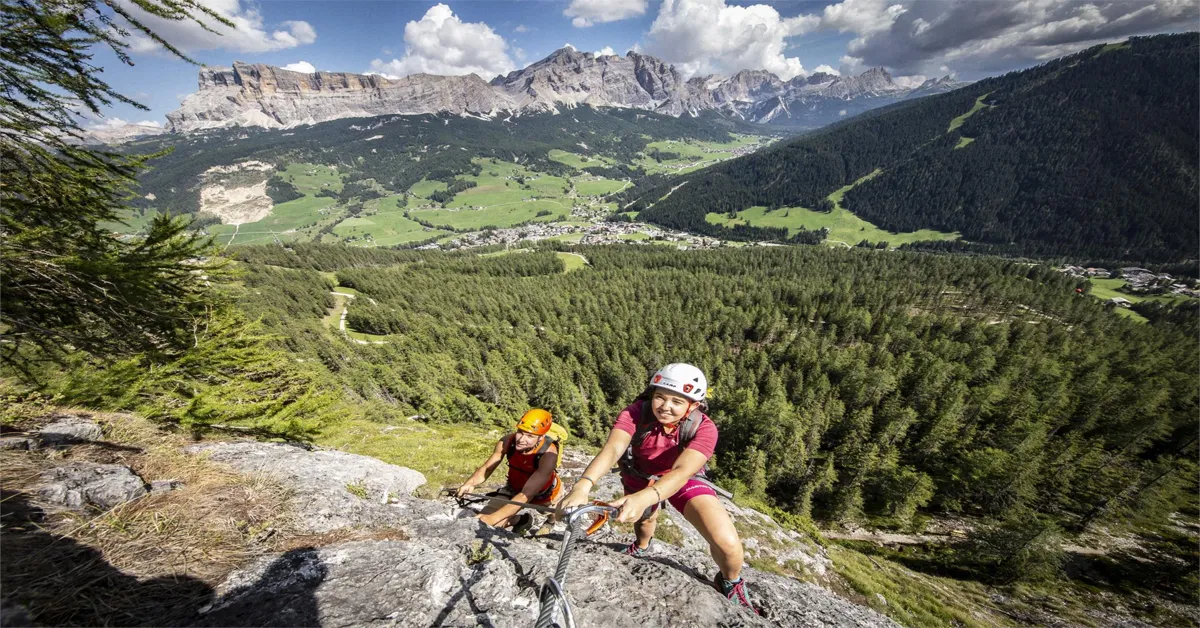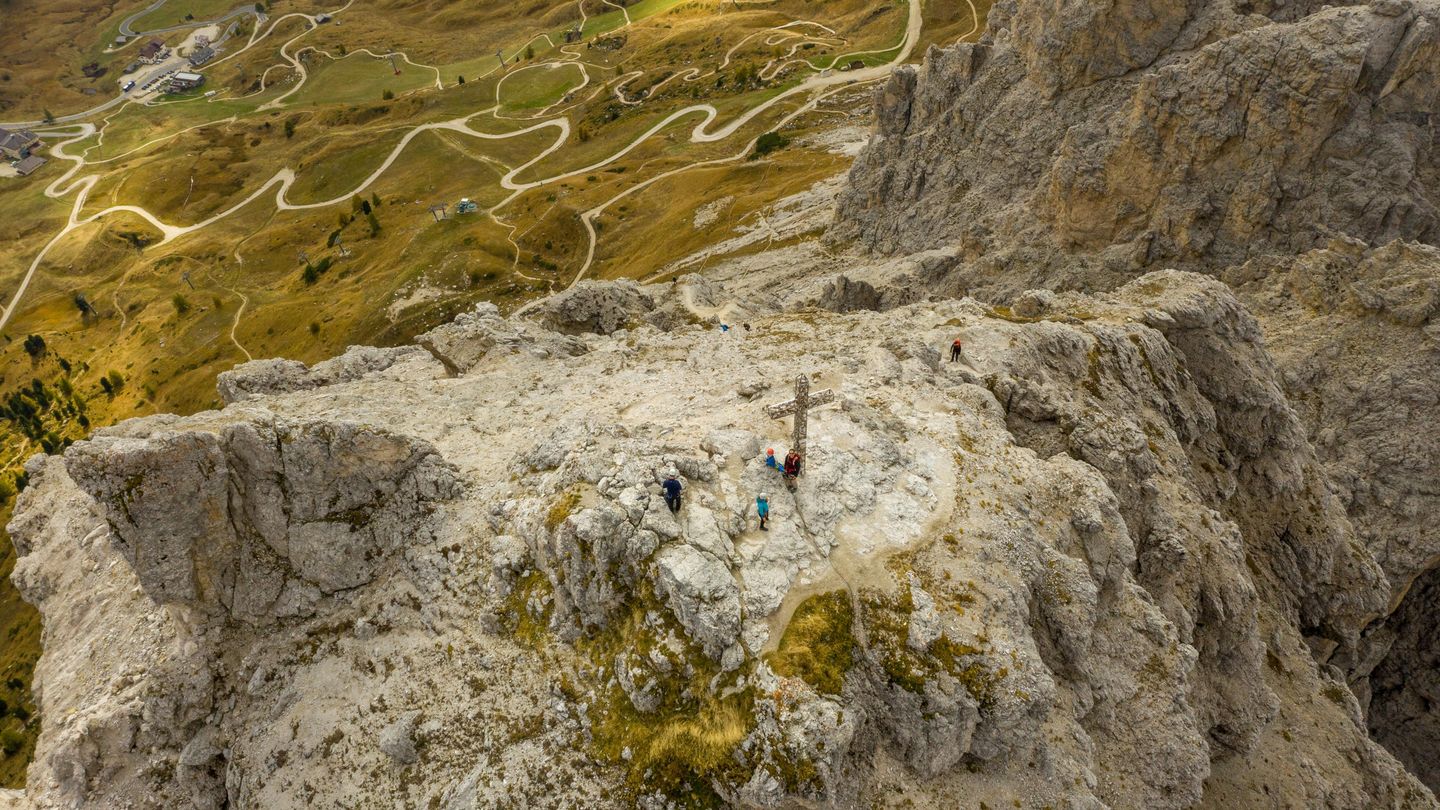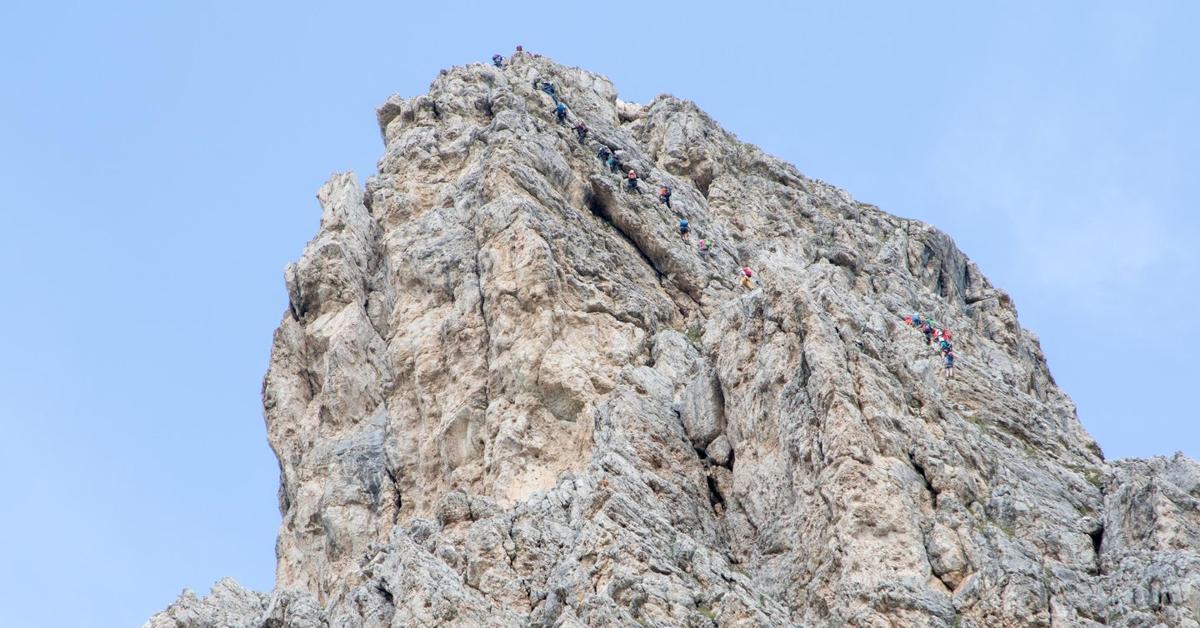Are you thinking of trying out the via ferrata routes in Alta Badia? It will be a simply wonderful experience, surrounded by the spectacle of the Dolomites. Via ferratas are mountain routes that are equipped (usually with cables, ladders and bridges) in such a way that they can be climbed even by non-experts.
However, even when climbing an equipped route such as a via ferrata, safety is obviously a key factor: having the right climbing equipment can mean the difference between an exciting experience and serious risks. It is therefore necessary to ensure that you have a via ferrata kit that can reduce the possibility of injury, but not only that.
It is important to choose routes that suit your level of experience and preparation. Choosing the right via ferrata will allow you to face the challenge in a safe and rewarding way, enjoying the adventure to the fullest. Here is a selection of the best via ferrata routes in Alta Badia, suitable both for experts and for beginners who want to try this adventure for the first time.
- The best via ferrata routes in Alta Badia for every level of difficulty
-
- Ferrata Brigata Tridentina at Pisciadù: medium difficulty
- Via ferrata Piz da Lech: for experts
- Ferrata Sas dla Crusc and Sas dles Diesc: two via ferrata routes for two levels of difficulty
- Via ferrata Les Cordes: ideal for inexperienced climbers
- Gran Cir and Piccolo Cir via ferrata: for beginners and novices
-
- Equipment to use for climbing a via ferrata in Alta Badia
- Useful tips for your first time on a via ferrata
The best via ferrata routes in Alta Badia for every level of difficulty
Alta Badia offers some of the most spectacular fixed rope routes in the Dolomites. Here you will find routes and itineraries of moderate difficulty, perfect for beginners who want to try this fascinating activity, to more demanding challenges that will test even the most experienced climbers.
Ferrata Brigata Tridentina at Pisciadù: medium difficulty
The via ferrata Tridentina at Pisciadù is one of the most exciting experiences that the Dolomites have to offer. Located in the Sella Group, it is famous for its spectacular views and its challenging route. It starts at Passo Gardena, where a short approach leads to the starting point of the equipped route. As you climb, you will encounter a series of exciting passages, including suspension bridges and metal ladders, with breathtaking views at every turn.
One of the highlights of the Tridentina is the suspension bridge near the Exner Tower, which offers an adrenaline rush and unparalleled views of the surrounding landscape. At the end of the via ferrata, the Franco Cavazza Refuge in Pisciadù welcomes you with its charming alpine pond, ideal for a relaxing break. The whole itinerary takes about 4-5 hours and will give you an unforgettable experience among the majestic peaks of the Dolomites.
Before starting your adventure, do not forget to buy or rent the via ferrata equipment, consisting of harness, helmet and carabiners, available in the Botëghes Lagazoi shop in San Cassiano or conveniently in our online shop!

Via ferrata Piz da Lech: for experts
The Piz da Lech via ferrata is a short but intense route, recommended for those who already have a good climbing technique. Starting from the cable car station of Corvara, it winds along the eastern side of the Sella Group and reaches the summit of Piz da Lech at 2916 meters.
The route starts with a technical and vertical wall. An interesting passage is the ascent of the iron ladders that overcome a thirty-meter overhanging wall. With a development of 330 meters and an elevation gain of 400 meters.
At the end of the fixed rope route, a path leads to the summit in about 20 minutes, offering a spectacular view of the Dolomites. The descent follows a clearly visible ridge with a few sections of fixed rope route to the Piz Boe cable car. The whole route takes about 4 hours and is an exciting experience.
Ferrata Sas dla Crusc and Sas dles Diesc: two via ferrata routes for two levels of difficulty
The double via ferrata Sas dla Crusc and Sas dles Diesc start from the Rifugio Santa Croce and offer a unique and exciting experience. The first via ferrata, which leads to Forcella dla Crusc, is considered easy and suitable for less experienced climbers, with three short vertical stretches and several passages equipped for safety on exposed paths.
The route to Cima Dieci, on the other hand, is more demanding. It is very exposed and requires a good head for heights, with a steep and technical first half. The total duration of the route is about 7 1/2 hours and requires a good physical preparation due to the long stretches and the considerable height difference.
This combination of fixed rope routes offers an intense and rewarding adventure, allowing you to explore some of the most spectacular scenery in the Dolomites, with breathtaking views along the entire route.

Via ferrata Les Cordes: ideal for inexperienced climbers
The Les Cordes via ferrata, located in La Villa in the Val Badia, is ideal for those who want to start climbing via ferrata. With a duration of about 2 hours, this route is moderately difficult but also accessible to beginners.
Well equipped and safe, it winds through the breathtaking scenery of the Dolomites. Unlike other via ferrata that aim to reach a summit, this one leads to the Gardenaccia hut, ideal for a relaxing break.
With equipped walls that facilitate climbing and a variety of viewpoints, the Les Cordes Ferrata is ideal for those who want an exciting but safe introduction to the world of via ferrata.

Gran Cir and Piccolo Cir via ferrata: for beginners and novices
The Gran Cir via ferrata is ideal for beginners. Starting from Passo Gardena, between Val Gardena and Val Badia, this easy route takes about 2 1/2 hours and is ideal for those who are approaching this type of mountain adventure for the first time.

That of the Little Cir, on the other hand, is of medium difficulty. It also starts at Passo Gardena and follows a dirt road to the top station of the Dantercepies gondola. This route, which takes about 2 hours, is short but varied, with compact rock walls that provide excellent grip.
Both offer an unforgettable adventure, allowing hikers to enjoy spectacular views and a unique climbing experience.

Equipment to use for climbing a via ferrata in Alta Badia
Climbing via ferrata requires maximum safety, and to ensure this it is essential to use the right equipment. This includes some basic equipment.
- Climbing helmets. First of all, it is necessary to use a suitable helmet to protect the head from possible falling rocks, from blows in the narrowest passages or from the shocks received during a possible fall. The models currently available from Lagazoi are light, comfortable and ventilated: pleasant even on the hottest summer days.
- Harness. Provides a safe and comfortable anchor point for connecting the via ferrata kit.
- Carabiners. After the helmet, the most important specific equipment for climbing a via ferrata is a set of ropes and heat shields to which two carabiners are attached. Via ferrata carabiners allow easy attachment of cables and steps and are therefore stronger than traditional climbing carabiners.
- Dissipator. The purpose of this device is to reduce the fall factor. By absorbing the energy produced by a fall, the dissipator greatly reduces the impact on the body, minimizing the risk of injury that could prove fatal.
- Gloves. Very important in order not to hurt yourself on the iron cables and to have the right grip, at Lagazoi.com you can buy different models of gloves, long or short-fingered. (Not available for rental).
- Elastic lanyards. Although in mountaineering practice the dynamic rope perfectly fulfills its function as a fall arrestor, here, since you are climbing individually, you need specific via ferrata lanyards.
If you don’t have the right equipment for a via ferrata, don’t worry: at Lagazoi we offer you the possibility to buy and rent via ferrata sets. You can go to our online shop or to our shop in San Cassiano, where you will find high quality equipment.
Clothing and shoes for a via ferrata in Alta Badia
In addition to the equipment, it is also very important to wear the right technical clothing to adapt to the climatic changes, preferring breathable and durable materials.
As already mentioned, the harness is essential for your protection; it must be well adjusted for maximum comfort and safety. Climbing gloves are also essential: they protect your hands from abrasions and improve your grip on cables and metal supports; they must be strong but at the same time allow good sensitivity. These cannot be rented for hygienic reasons, but are available for sale in our shop.
Another essential piece of clothing is footwear. When choosing via ferrata shoes, it is important to find ones that offer safety and comfort. A good sole will give you the right grip on different terrains, while the upper should be sturdy to protect your feet from impact, but also flexible to allow for easy movement. The toe box, also known as the climbing zone, should be flattened to provide good grip and sensitivity.
For more stability and protection, we recommend hiking boots (e.g. La Sportiva Aequilibrium) that provide excellent ankle support. If you are looking for more lightness and freedom of movement, you could opt for an approach shoes (e.g. La Sportiva TX4 Evo). On the other hand, if you are looking for a compromise between the two, mid boots are for you, offering a good balance between stability and mobility (e.g. Scarpa Mescalito mid).
But that’s not all: make sure your backpack is properly equipped before you start your trek. Find out what else you need to take with you!
What to put in your backpack before approaching a via ferrata
To approach a via ferrata with the proper equipment, start by choosing a climbing backpack. Compared to a general outdoor backpack, this type of pack allows you to keep your weight closer to your body, which improves your balance. In addition, its narrow and tall shape allows you to move more freely in tight spaces. The backpack also offers the possibility of attaching a climbing helmet. Inside, you will find international emergency numbers and instructions on how to notify mountain rescue.
Here’s what you never want to be without:
- A waterproof jacket / mid-layer / vest for temperature changes;
- A spare technical T-shirt;
- Sunglasses;
- A first aid kit for minor accidents;
- A hiking water bottle;
- Multi-function pocket knife;
- A headlamp (if you plan to hike at night).
Finally, we recommend that you use nylon bags to collect waste and keep the environment clean.
Useful tips for your first time on a via ferrata
Is this the first time you are preparing to climb a via ferrata in Alta Badia? It is an extraordinary experience, but it is understandable that it can be a little intimidating for those who have never climbed a vertical surface! However, even if you have no mountaineering experience, you should know that the feat is within your reach.
It is important to start with a simple via ferrata with few vertical steps. Assess your fitness level, as the length and verticality of the route can be challenging.
Don’t go alone: rely on professional mountain guides to accompany you and show you how to use the equipment properly. Guides are the only people licensed and trained to ensure your safety on the trail. Remember to always tell someone about your planned route.
When climbing, use both the rope and natural handholds to move forward and avoid overexerting your arms. Take small and safe steps to maintain balance and stability.
With the right preparation and equipment you will have an unforgettable and rewarding experience in Alta Badia!


